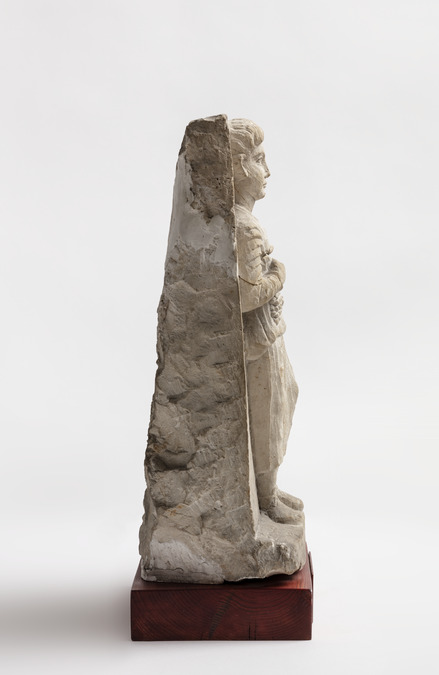Palmyrene loculus stele depicting a standing boy, Nûrbêl
Summary
A boy is represented on a grave stele from Palmyra, Syria. he object is well-preserved, only with small fragments missing from the frame. A four-lined inscription, with traces of red pigment, is indicated in the upper right corner. Here, two cracks are also visible. The portrait itself is also well-preserved: only the bird he is holding is slightly fragmented, along with the upper part of the tunic, the fingers on his right hand and also the visible crack by his right chest and upper right arm.
The boy, Nurbel is represented wearing a belted tunic. He is holding a bird and a bunch of grapes in front of his chest.
Description of object
The stele is rectangular with a male figure standing on a projecting plinth. The inscription to the left of the figure identifies the young boy depicted as Nûrbêl, depicted standing frontally with his weight resting on the right leg. He is portrayed on a framed stele with a projecting plinth. The overall object is well-preserved, only with small fragments missing from the frame. A four-lined inscription, with traces of red pigment, is indicated in the upper right corner. Here, two cracks are also visible. The portrait itself is also well-preserved: only the bird he is holding is slightly fragmented, along with the upper part of the tunic, the fingers on his right hand and also the visible crack by his right chest and upper right arm. He is shown in full frontal figure, gazing directly outwards.
His arms are bent, both of which are located in front of his torso. His feet are spaced apart, as he stands on a protruding plinth. Weight is shifted onto the right leg, with the left leg being relaxed and slightly bent at the knee. The arms and the legs of Nûrbêl do not seem to be the correct size in relation to his body, appearing to be smaller than expected. His hair is arranged in a single row of large, s-shaped curls all the way around his head. The individual strands of hair are indicated by short, curving, incised lines. His face, overally, is oval in shape, with a slightly protruding forehead and eyebrows are indicated by wide ridges. The eyelids are heavy, almond-shaped but rounded, the eyes are large and the pupils are indicated by circular incisions. The nose is straight and the ears are slightly protruding with indication of helix, anti-helix and earlobes. The mouth is small, but full, and his chin is protruding with a slight indication of a dimple. His neck is short. Nûrbêl is wearing a belted, long-sleeved tunic with a wide, rounded neckline. The heavy folds of the tunic are indicated by deep grooves along the sleeves and by semi-circular ridges down the torso and down the lower part of the tunic. The belt is not visible, however, but still creates a heavy fold. He is also wearing boots. He holds a bunch of grapes in his right hand and the left hand is holding a bird, which is facing towards his right side.
Inscription: ḤBL | NWRBL | BR TYMY | MTNY
Alas! Nûrbêl son of Taimai (son of (?)) Mattenai. CIS: 4133 PAT: 0485Choice of methods
Visual examination
- Macroscopic
Bibliography
Ingholt Archive
J.-B. Chabot (1922), Choix d’inscriptions de Palmyre, Paris, pl. XXVIII, no. 13.
J.K. Stark (1971), Personal Names in Palmyrene Inscriptions, Oxford, 39.
M.A.R. Colledge (1976), The Art of Palmyra, London, 244.
H. Ingholt (1928), Studier over Palmyrensk Skulptur, København, 20, PS 518.
F.O. Hvidberg-Hansen & G. Ploug (1993), Palmyra Samlingen, Ny Carlsberg Glyptotek, København, 113, no. 69.
R. Raja (2017), To be or not to be depicted as a priest in Palmyra. A matter of representational spheres and societal values in T. Long & A.H. Sørensen (eds.) Positions and Professions in Palmyra, Copenhagen, 122, fig. 9.
- IN 1147
- Stele
- c. 150-170 C.E.
- Roman Imperial
- Limestone
- Acquired by Puttmann in Syria. Original grave context unknown.
- H: 42 cm.; W: 23.5 cm.; D: 15.5 cm. Figure, H: 37 cm.; W: 13 cm.; D: 5.5 cm. Head, H: 7.5 cm.; W: 6 cm.; D: 4 cm.





